"Demystifying the Intricacies of E-Ink Technology: A Fresh Look at the Future of Displays"
Introduction: E-Ink technology is an innovative display technology that has been quietly revolutionizing the way we interact with digital devices. It has significant advantages that make it a contender in the battle for display superiority. E-Ink, short for Electronic Ink, is a type of display technology that mimics the appearance of ink on paper. It made its first significant splash in the consumer market with the release of the Amazon Kindle in 2007. However, its origin dates back to the 1970s, when Xerox PARC (Palo Alto Research Center) started researching electrophoretic displays, the foundation for today's E-Ink.

The E-Ink Advantage: Energy Efficiency and Visibility
One of the standout features of E-Ink technology is its energy efficiency. Unlike traditional LCD or OLED displays that require constant power to display an image, E-Ink only uses power when changing the displayed image. In other words, if you’re reading a page on an E-Ink display, no power is used until you turn the page. This makes E-Ink displays the perfect choice for devices like e-readers, wearable tech, and digital signage, where battery life is paramount.
Additionally, E-Ink screens boast excellent visibility, even in bright sunlight. This is because they rely on ambient light, just like paper.
The Future of E-Ink: Color and Video
Recent developments in E-Ink technology have brought us color E-Ink displays, also known as Advanced Color ePaper (ACeP). These displays can produce up to 32,000 different colors, making them a potential game-changer for industries like digital signage and education. The first consumer device to feature a color E-Ink display, the PocketBook Color, was launched in mid-2020.
Another area of E-Ink technology that’s making strides is video playback. Although E-Ink screens have traditionally been too slow to display moving images effectively, recent advancements have improved refresh rates significantly.
E-Ink’s Market Impact and Price Considerations
E-Ink technology is not limited to e-readers anymore. It’s being used in everything from smartwatches to phones, and even digital signage. It’s a niche market, but it’s growing. The global E-Ink display market was valued at $699.8 million in 2018 and is expected to reach $1,506.2 million by 2026, according to Allied Market Research.
As for pricing, devices with E-Ink displays tend to be more expensive than their LCD or OLED counterparts. This is due to the complexity of manufacturing E-Ink displays. However, as the technology matures and economies of scale come into play, prices are expected to fall.
E-Ink’s Place in the Display Landscape
E-Ink technology offers a unique combination of features that make it a compelling choice for many applications. Its energy efficiency and excellent readability under sunlight are unmatched by any other display technology currently on the market. While its high price and slow refresh rate currently limit its applicability, recent advancements promise to broaden its appeal. Whether E-Ink will ever challenge the dominance of LCD and OLED in the broader display market remains to be seen, but its future definitely looks bright.





